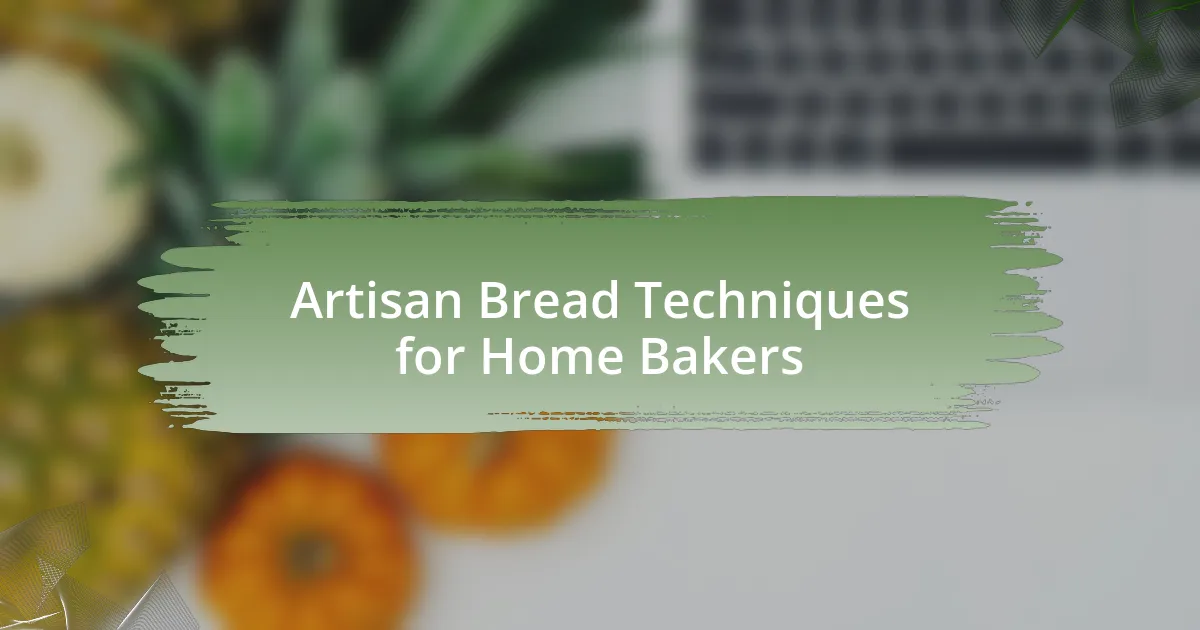The article focuses on achieving the perfect crust on homemade breads, emphasizing its importance in texture, flavor, and overall quality. Key factors influencing crust development include baking temperature, moisture content, and ingredient selection, with optimal temperatures ranging from 425°F to 475°F. Techniques such as using steam, preheating baking surfaces, and selecting high-protein flours are discussed to enhance crust characteristics. Common mistakes, troubleshooting tips, and advanced methods for improving crust quality are also outlined, providing a comprehensive guide for bakers seeking to perfect their bread crusts.

What is the Perfect Crust in Homemade Breads?
The perfect crust in homemade breads is characterized by a golden-brown color, a crisp texture, and a satisfying crunch when bitten into. Achieving this ideal crust involves proper hydration of the dough, the right baking temperature, and steam during the initial baking phase, which helps create a desirable outer layer. Research indicates that a crust forms best when the dough is baked at temperatures between 425°F to 475°F, allowing for Maillard reaction and caramelization, which contribute to flavor and color.
How does the crust affect the overall quality of bread?
The crust significantly affects the overall quality of bread by contributing to its texture, flavor, and aroma. A well-developed crust provides a desirable crunch and contrast to the soft interior, enhancing the eating experience. Additionally, the Maillard reaction, which occurs during baking, creates complex flavors and aromas in the crust, making the bread more appealing. Studies show that a thicker crust can also help retain moisture in the bread, prolonging freshness. Thus, the crust plays a crucial role in defining the sensory attributes and shelf life of bread.
What are the characteristics of a perfect crust?
A perfect crust is characterized by a golden-brown color, a crisp texture, and a pleasing aroma. The golden-brown color indicates proper caramelization of sugars and Maillard reaction, which enhances flavor. A crisp texture results from the right balance of moisture and heat during baking, allowing steam to escape while forming a sturdy outer layer. Additionally, a pleasing aroma arises from the development of complex flavors during the baking process, contributing to the overall sensory experience of the bread. These characteristics are essential for achieving a desirable crust that complements the interior of the bread.
Why is crust texture important for different types of bread?
Crust texture is important for different types of bread because it influences flavor, aroma, and overall eating experience. A thick, crunchy crust, typical of artisan breads, enhances flavor through caramelization and Maillard reactions during baking, while a soft crust, found in sandwich breads, provides a tender bite that complements fillings. Additionally, the crust acts as a barrier, retaining moisture within the bread, which is crucial for maintaining freshness. Studies show that crust texture can significantly affect consumer preferences, with many favoring breads that offer a satisfying contrast between crust and crumb.
What factors influence the formation of a crust?
The formation of a crust on homemade bread is influenced by several key factors, including moisture content, temperature, and baking time. Moisture content affects the dough’s ability to create steam during baking, which is essential for crust development. Higher temperatures promote Maillard reactions, leading to browning and flavor enhancement. Additionally, the duration of baking allows for the crust to harden and develop texture. These factors work together to create the desired crust characteristics in bread.
How does baking temperature impact crust development?
Baking temperature significantly impacts crust development by influencing the Maillard reaction and caramelization processes. Higher temperatures, typically between 450°F to 500°F, promote rapid browning and a thicker crust due to increased moisture evaporation and enhanced sugar reactions. Research indicates that at these temperatures, the crust can form a desirable crispy texture while maintaining a soft interior, as seen in artisan bread baking practices. Conversely, lower temperatures result in a pale, softer crust, as the Maillard reaction occurs more slowly, leading to less flavor and texture development.
What role does humidity play in achieving the perfect crust?
Humidity plays a crucial role in achieving the perfect crust by influencing moisture retention and evaporation during the baking process. When humidity levels are optimal, the dough can retain sufficient moisture, allowing for better steam production in the oven, which contributes to a crisp and well-developed crust. Studies have shown that higher humidity can enhance the Maillard reaction, leading to improved browning and flavor development in the crust. Conversely, low humidity can result in a dry crust that lacks texture and flavor. Therefore, managing humidity is essential for creating an ideal baking environment that promotes the desired crust characteristics.
Why is the choice of ingredients crucial for crust quality?
The choice of ingredients is crucial for crust quality because they directly influence the texture, flavor, and overall structure of the crust. For instance, high-protein flour contributes to gluten development, which creates a chewy and well-structured crust, while fats like butter or oil can lead to a tender and flaky texture. Additionally, the presence of sugars can enhance browning through the Maillard reaction, resulting in a more flavorful and visually appealing crust. Studies have shown that the specific ratios and types of ingredients, such as using bread flour versus all-purpose flour, can significantly affect the final crust characteristics, making ingredient selection a key factor in achieving the desired crust quality in homemade breads.
How do different flours affect crust texture and flavor?
Different flours significantly influence crust texture and flavor in bread. For instance, bread flour, which has a higher protein content (around 12-14%), creates a chewier crust due to increased gluten formation, resulting in a robust structure. In contrast, all-purpose flour, with a protein content of about 10-12%, yields a softer crust and a more tender crumb, making it suitable for a variety of baked goods. Whole wheat flour, containing the entire grain, contributes a denser texture and a nuttier flavor, enhancing the overall taste profile of the bread. Additionally, specialty flours like rye or spelt can impart unique flavors and textures; rye flour tends to produce a denser, darker crust with a slightly sour taste, while spelt flour offers a mild, sweet flavor and a lighter texture. These variations in flour types directly affect the final product’s crust characteristics, demonstrating the importance of flour selection in achieving the desired bread outcome.
What impact do fats and sugars have on crust formation?
Fats and sugars significantly influence crust formation in baked goods. Fats, such as butter or oil, create a tender texture by coating flour particles, which inhibits gluten development and results in a softer crust. Additionally, fats contribute to browning through the Maillard reaction, enhancing flavor and color. Sugars, on the other hand, promote caramelization during baking, leading to a darker and more flavorful crust. The presence of sugar also affects moisture retention, which can impact the overall texture of the crust. Together, fats and sugars play crucial roles in achieving the desired crust characteristics in homemade breads.
How can techniques improve crust quality?
Techniques can improve crust quality by optimizing baking conditions and ingredient interactions. For instance, using steam in the oven during the initial baking phase enhances crust formation by allowing the dough to expand before the crust sets, resulting in a thicker and crunchier exterior. Additionally, incorporating high-protein flour increases gluten development, which contributes to a chewier and more robust crust. Research indicates that a baking temperature of around 450°F (232°C) is ideal for achieving a well-browned crust due to the Maillard reaction, which enhances flavor and color.
What are the best baking methods for a crispy crust?
The best baking methods for a crispy crust include using high temperatures, steam, and proper baking surfaces. High temperatures, typically around 450°F to 500°F, promote rapid moisture evaporation, which is essential for achieving a crisp exterior. Introducing steam during the initial baking phase helps to keep the crust soft for longer, allowing for better expansion and a more developed crust. Additionally, using a baking stone or steel can enhance heat retention and provide a more even cooking surface, contributing to a superior crust texture. These methods are supported by culinary science, which indicates that moisture control and heat application are critical factors in crust formation.
How does steam in the oven contribute to crust perfection?
Steam in the oven contributes to crust perfection by creating a moist environment that allows the bread to expand fully before the crust sets. This moisture delays the formation of the crust, enabling better oven spring and a lighter texture. Additionally, steam helps to gelatinize the starches on the surface of the dough, resulting in a glossy, crisp crust once the moisture evaporates during baking. Studies have shown that bread baked with steam has a superior crust quality compared to bread baked in a dry oven, as the steam enhances the Maillard reaction, which is responsible for browning and flavor development.

What are Common Mistakes in Achieving the Perfect Crust?
Common mistakes in achieving the perfect crust include using insufficient heat, neglecting proper hydration, and failing to preheat the baking surface. Insufficient heat results in a pale crust, as bread requires high temperatures to develop a golden-brown exterior. Neglecting proper hydration can lead to a dry crust, as moisture is essential for steam creation during baking, which contributes to crust formation. Failing to preheat the baking surface, such as a pizza stone or baking steel, prevents the bread from getting an initial burst of heat, which is crucial for crust development. These factors collectively hinder the ability to achieve a desirable crust texture and color.
What errors do bakers often make when aiming for a perfect crust?
Bakers often make the error of not properly preheating their ovens, which can lead to uneven baking and a lack of crust development. Insufficient oven temperature prevents the Maillard reaction, essential for browning, from occurring effectively. Additionally, bakers may neglect to use steam during the initial baking phase, which is crucial for creating a crispy crust by allowing the dough to expand before the outer layer hardens. Another common mistake is using the wrong type of flour; for instance, low-protein flours do not provide the necessary structure for a robust crust. Lastly, bakers sometimes fail to monitor baking time closely, resulting in underbaked or overbaked loaves that do not achieve the desired crust texture.
How can over-proofing affect crust quality?
Over-proofing negatively affects crust quality by causing the dough to lose its structural integrity, resulting in a pale and soft crust. When dough is over-proofed, the yeast exhausts its food supply, leading to insufficient gas retention, which diminishes the ability of the crust to develop a desirable color and texture during baking. Studies show that optimal fermentation time is crucial for achieving a well-defined crust, as over-proofed dough often fails to rise properly in the oven, leading to a lack of crispness and a chewy rather than crunchy texture.
What happens when the oven temperature is not calibrated correctly?
When the oven temperature is not calibrated correctly, it leads to uneven baking results, affecting the texture and crust of homemade breads. An incorrect temperature can cause bread to either underbake or overbake; for instance, if the oven is too hot, the crust may burn before the inside is fully cooked, while a cooler oven can result in a pale, soft crust and dense interior. Studies show that precise temperature control is crucial for achieving the Maillard reaction, which is responsible for the desirable crust color and flavor in baked goods. Therefore, proper calibration is essential for optimal baking outcomes.
How can these mistakes be avoided?
To avoid mistakes in achieving the perfect crust on homemade breads, bakers should ensure proper oven temperature and humidity levels. Maintaining an oven temperature between 450°F to 500°F allows for optimal crust formation, while introducing steam during the first few minutes of baking enhances crust development. Research indicates that steam helps gelatinize the starches on the bread’s surface, resulting in a crispier crust. Additionally, using a baking stone or preheated cast iron skillet can improve heat retention, further contributing to a well-formed crust.
What are the best practices for monitoring dough during proofing?
The best practices for monitoring dough during proofing include observing the dough’s volume increase, checking for surface texture, and conducting the poke test. Monitoring the volume increase ensures that the dough has risen adequately, typically doubling in size, which indicates proper fermentation. The surface texture should appear smooth and slightly domed, signaling that the gluten structure is developing correctly. The poke test involves gently pressing a finger into the dough; if the indentation springs back slowly, the dough is ready, while if it collapses, it may be over-proofed. These methods are widely recognized in baking literature, such as “The Bread Baker’s Apprentice” by Peter Reinhart, which emphasizes the importance of visual and tactile cues in dough proofing.
How can bakers ensure proper oven settings for crust development?
Bakers can ensure proper oven settings for crust development by preheating the oven to the correct temperature, typically between 425°F to 475°F, depending on the type of bread. This high temperature allows for rapid steam generation, which is crucial for achieving a crispy crust. Additionally, using a baking stone or steel can help maintain consistent heat, while introducing steam during the initial baking phase enhances crust formation. Research indicates that steam in the oven can improve crust texture and color by promoting Maillard reactions, which are responsible for browning.

What Advanced Techniques Can Enhance Crust Quality?
Advanced techniques that can enhance crust quality include using steam during baking, employing a preheated baking surface, and incorporating specific ingredients like malt or diastatic malt powder. Steam creates a humid environment that allows the crust to expand before it sets, resulting in a better rise and texture. A preheated baking stone or steel provides direct heat, promoting a crispier crust. Additionally, the use of malt enhances browning through the Maillard reaction, contributing to flavor and color. These methods are supported by baking science, which emphasizes the importance of heat and moisture in crust development.
How can sourdough contribute to a better crust?
Sourdough contributes to a better crust by enhancing the Maillard reaction during baking, which creates a deeper color and richer flavor. The natural fermentation process in sourdough produces organic acids and enzymes that strengthen the gluten structure, allowing for better gas retention and a more robust rise. This improved rise leads to a thicker crust as the dough expands in the oven. Additionally, the acidity from sourdough helps to create a crispy exterior by promoting moisture evaporation during baking, resulting in a desirable texture.
What is the role of fermentation in crust texture?
Fermentation plays a crucial role in developing crust texture by producing gases that create air pockets and enhancing flavor through the breakdown of sugars. During fermentation, yeast and bacteria metabolize carbohydrates, releasing carbon dioxide, which causes the dough to rise and form a light, airy structure. This process also contributes to the Maillard reaction during baking, which is responsible for the browning and crispiness of the crust. Studies have shown that longer fermentation times can lead to a more complex flavor profile and improved crust characteristics, as seen in artisanal bread-making practices.
How does using a pre-ferment affect the final crust?
Using a pre-ferment enhances the final crust by promoting better browning and texture. The fermentation process in pre-ferments develops complex sugars and acids, which contribute to the Maillard reaction during baking, resulting in a deeper color and richer flavor in the crust. Additionally, the increased hydration from the pre-ferment can lead to a crisper crust due to steam retention, which is essential for achieving a desirable crust structure.
What are some unique methods to experiment with crusts?
Unique methods to experiment with crusts include using different types of flour, incorporating fats, and adjusting baking temperatures. For instance, using bread flour instead of all-purpose flour can enhance gluten development, resulting in a chewier crust. Adding fats like butter or olive oil can create a richer flavor and a softer crust. Additionally, baking at higher temperatures can produce a crispier exterior due to increased Maillard reaction, which enhances browning. These methods are supported by culinary science, which shows that variations in ingredients and techniques significantly affect the texture and flavor of bread crusts.
How can different baking surfaces impact crust results?
Different baking surfaces significantly impact crust results by influencing heat distribution and moisture retention during the baking process. For instance, a stone baking surface retains and radiates heat evenly, promoting a crispier crust due to higher thermal mass, while a metal baking sheet heats up quickly but may lead to uneven browning. Research indicates that baking on a pizza stone can yield a crust with a desirable texture and color, as it absorbs moisture from the dough, resulting in a drier surface that enhances crust formation. Conversely, silicone mats can create a softer crust due to their insulating properties, which prevent the dough from achieving the same level of crispness.
What are the benefits of using a baking stone or steel?
Using a baking stone or steel significantly enhances the quality of homemade bread by providing superior heat retention and distribution. This results in a more evenly baked crust, which is crucial for achieving the desired texture and flavor. The high thermal mass of baking stones or steels allows for a rapid transfer of heat to the dough, promoting better oven spring and a crispier crust. Studies have shown that bread baked on these surfaces can achieve a crust temperature of around 450°F, compared to lower temperatures on standard baking sheets, leading to improved Maillard reactions that develop flavor and color.
What practical tips can help achieve the perfect crust?
To achieve the perfect crust on homemade bread, use a combination of high oven temperatures, steam, and proper dough hydration. High temperatures, typically between 450°F to 500°F, promote rapid oven spring and browning. Introducing steam during the first few minutes of baking helps create a crispy exterior by delaying crust formation, allowing the bread to expand fully. Additionally, maintaining a hydration level of around 65% to 75% in the dough contributes to a tender crumb and a well-formed crust. These techniques are supported by baking science, which shows that steam and high heat are critical for optimal crust development.
How can bakers troubleshoot common crust issues?
Bakers can troubleshoot common crust issues by identifying specific problems such as excessive browning, pale crust, or toughness. For excessive browning, reducing oven temperature or covering the bread with foil can help; this is supported by the fact that high temperatures can cause rapid caramelization of sugars. If the crust is too pale, increasing baking time or using a steam method can enhance browning, as steam helps develop a better crust texture. Tough crusts may result from over-kneading or using too much flour; adjusting the kneading time and flour quantity can improve the crust’s softness, as evidenced by the principle that gluten development affects texture.
What are the best practices for cooling bread to maintain crust quality?
To maintain crust quality when cooling bread, it is essential to place the bread on a wire rack immediately after baking. This practice allows for proper air circulation around the bread, preventing steam from accumulating and softening the crust. Additionally, cooling bread at room temperature rather than in a closed environment helps preserve the crispness of the crust. Research indicates that cooling bread on a wire rack can reduce moisture retention by up to 50%, thereby enhancing crust texture.




